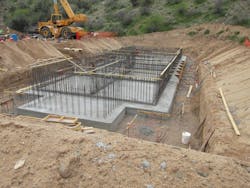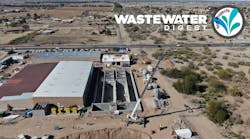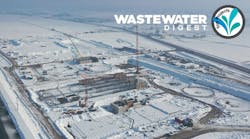Cost: $6,583,504
Location: Wickenburg, Ariz.
Year: 2018-12-01
Size: 208 gpm
Owner: Town of Wickenburg
Designers: GHD Inc.
Contractor: Currier Construction
The Wickenburg Ranch Water Reclamation Facility (WRWRF) provides wastewater treatment and recycling for the Wickenburg Ranch community in Wickenburg, Ariz. This community includes single-family residences, casitas, a 40,000-sq-ft clubhouse, a dog park, trails, a lunar lounge, a yoga park, tennis courts and a sports complex, an 18-hole golf course, and an executive short course and watering hole.
The community is located 10 miles north of downtown Wickenburg and is isolated from the existing water and wastewater infrastructure. In order to support a community of this magnitude, a robust wastewater treatment system was required, and the WRWRF currently serves as the backbone of that development. There is significant water demand from the community to keep golf courses and landscaping green year-round. The community was looking for long-term solutions to reduce the amount of groundwater consumed for irrigation. This project was designed for reclamation.
The developer and the town of Wickenburg created a vision for a water reclamation facility that would meet long-term wastewater treatment goals and provide reclaimed water for beneficial reuse. The vision was to provide a municipal-quality facility to treat the wastewater generated at the Wickenburg Ranch community and to produce reclaimed water to offset the amount of groundwater needed to irrigate golf turf and fulfill landscaping requirements.
“The most important goal was to minimize the effort to sustain the quality of the effluent. We believe this was accomplished and demonstrated over the first 12 months of operations. The initial projection of staffing that was recommended by the designer was two full-time employees and one part-time employee to maintain [a] seven-day-a-week operation, with A+ effluent for beneficial reuse,” said Frederick Tack, service group manager for GHD Inc. “The town has been able to sustain compliant operations during that time with one full-time employee and one part-time employee dedicated to the facility.”
Ease of Operation
This goal included the evaluation and selection of equipment, as well as the application and orientation to provide good ergonomics of the movements of the operators, reduce maintenance and replacement frequency, and simplify the controls and operations of the WRWRF.
This approach started with a design to lift the influent wastewater through the headworks and into the reactor, where a gravity flow could be introduced. This complemented the selection of the membrane bioreactor (MBR) technology, where pumps must be used to create a vacuum to draw permeate out of the reactor. The permeate then gravity-flows through the deactivation process prior to the effluent lift station. This provided the benefit of being able to drain the entire reactor, preventing the need to raise and lower pumps to remove wastewater for maintenance in the future.
“Our largest obstacle was not having minimum flow required at the time of commissioning. This ended up taking an additional 12 months to gain a minimum flow of 10,000 [gal per day (gpd)] to fully commission the WRWRF. The designer and owner developed a plan to commission the WRWRF with clean water once construction was complete, to enable the start of warranties and to demobilize the contractor and save budget,” Tack said. “During the next 12 months, GHD operated the facility a few days a week to monitor and ensure the mechanical systems maintained functionality and to ensure the facility was ready for dirty water commissioning once the minimum flows were established. At the time of full commissioning, GHD and the owner were able to commission the facility within 30 days and successfully train the town staff and begin regulatory reporting.”
Minimize Expansion Costs & Service Interruptions
The WRWRF has an average day capacity of 100,000 gpd and a peak day capacity of 300,000 gpd in Phase 1, which is planned to be expanded in Phase 2 to the average day capacity of 365,000 gpd, utilizing the same footprint with only minor equipment additions. This foresight was an innovation implemented to maximize the life cycle and minimize the long-term operational and maintenance costs.
The techniques implemented on the project provide for the extended life cycle of this facility by promoting the use of high-quality base infrastructure with innovative technologies to enhance and sustain the high quality of the effluent. The decisions made by the team during the planning and design were well executed by the contractor and serve the town’s operational and maintenance team to this day.
“The project exceeded our expectations and addressed all stakeholder concerns while providing a technically excellent design, on time, and on budget” said Matt Egan, town of Wickenburg operations manager, water/wastewater/electric.
Project Year: 2018-12-01Contractor: Currier ConstructionDesigners: GHD Inc.Owner: Town of WickenburgLocation: Wickenburg, Ariz.Cost: $6,583,504Size: 208 gpm

